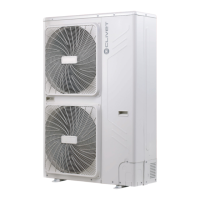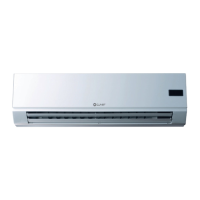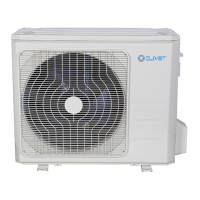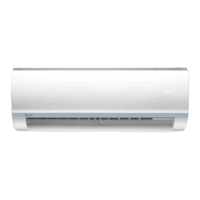39
Starting up the system
6 STARTING UP THE SYSTEM
6.1 Flushing the pipes
The refrigerant piping must be flushed with nitrogen to
remove dust, moisture and other particles that could
cause the compressor to malfunction if not eliminated
before the system is put into operation.
Flushing should be carried out after completing
connection of the piping, with the exception of final
connections to indoor units.
l
WARNING
Flushing must be performed before connecting
to indoor units.
a
CAUTION
Use only nitrogen for flushing. Do not use
carbon dioxide since it can create condensation
in the pipes. Oxygen, refrigerant, flammable
gases and toxic gases must not be used for
flushing. The use of such gases can cause fire
or explosion.
The flushing procedure is as follows:
1 Cover the inlets and outlets for the indoor units to
prevent dirt from being sucked inside during flushing
of the pipes.
2 Attach a pressure reducing valve to the cylinder of
nitrogen.
3 Connect the outlet of the pressure reducing valve to
the inlet on the liquid (or gas) side of the outdoor unit.
4 Use blanking plugs to block all openings on the liquid
(gas) side except for the opening on the indoor unit
(N) which is farthest from the outdoor unit.
5 Begin to open the valve of the cylinder of nitrogen
before gradually bringing the pressure to 0.5bar.
6 Allow the nitrogen to flow to the opening of the indoor
unit (N).
7 Clean the opening with a cloth until no more dirt or
moisture comes out. Check with a clean cloth that the
opening is clean.
8 Seal the opening
Repeat steps 7 and 8 for all the outlets of the indoor units,
from the furthest to the closest to the outdoor unit.
9 Seal all the openings.
L
1
L
2
N
1
N
2
N
3
N
5
N
6
N
4
L
3
L
4
L
5
a
A
B
D
E
C
b
c
e
f
d
Fig. 63
6.2 Gas leak test
A leak test must be carried out before the system is put
into operation, in order to avoid failures caused by the
leaking of refrigerant.
a
CAUTION
Use dry nitrogen only. Do not use oxygen,
flammable gases and toxic gases. The use of
such gases can cause fire or explosion.
m
CAUTION
Make sure that all the stop valves of the
outdoor unit are closed tightly.
– Connect the outdoor unit and indoor units and
create a vacuum in the piping at -0.1Mpa.
A vacuum pump with a minimum capacity of 80-120 litres/
minute is required for vacuum operations.
If the required value is not reached, it is recommended to
carry out further drying using the triple vacuum procedure.
– Fill the internal piping with nitrogen at 0.3Mpa via
the needle valve of the liquid stop valves (3). Leave
to act for at least 3 minutes.
Do not open the liquid (1) or gas (2) stop valves. Observe
the pressure gauge to check for significant leaks. If there
is such a leak, the hand of the pressure gauge will go
down rapidly.
– Fill the system with nitrogen at 1.5Mpa and leave to
act for at least 3 minutes.
Observe the pressure gauge to check for small leaks. If
there is such a leak, the hand of the pressure gauge will
go down rapidly.
– Fill the system with nitrogen at 4.0Mpa and leave
to act for at least 24 hours.
– Write down the initial room temperature (Ti).
A change in the room temperature of 1°C corresponds to
a change in the pressure of the nitrogen charged in the
line of 0.01MPa (0.1bar). Use this correction factor when
comparing the final room temperature (Tf) with the initial
one (Ti).

